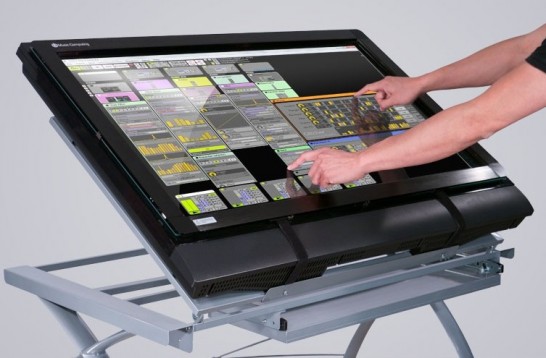Music Computing has introduced MotionCommand – a line of massive touchscreen controllers designed for music and media.
Music Computing is an Austin-based startup headed by Victor Wong, who previously headed Open Labs.
Currently, the company has four MotionCOMMAND multi-touchscreen products available: ClearView, LCD, Rack and WorkCenter.
There are two versions – one driven by an HD video projector designed for live performance that is transparent on both sides; and one driven by an HD LCD television for studio use. Standard sizes are 32-inch and 42-inch, but special order versions up to 200-inches diagonally are also available.
Options include multi-touchscreen controllers integrated into a control console complete with Music Computing’s computer DAW (digital audio workstation) computer core and audio interface.
“MotionCOMMAND touchscreen products provide people with the ability to work in a more natural state leading to increased efficiency, better control over software interfaces and the elimination of having to map software controls to hardware controllers,” says Wong.
The controllers are compatible Windows and Mac OS. Prices for standard configurations range from $1,499 to $2,299 (U.S. MSRP).
MotionCommand Video Preview


This would be great until someone comes in and starts hammering on it like they do when they try to point things out on my standard lcd and break the glass! People are great.
Needs more knobs.
more overpriced fail shit from the people behind Open Labs… who is investing in these guys?
this like their other products seems more about an aesthetic than an actual tool
Right on Rust. Getting real bored with all these interfaces. Don't matter how much control you have, its the sounds that matter. But there's a lot of people who only live for the GAS.
Say what you want–I'd take one of these over an iPad any day 🙂
possible issues…
1. dirty screen (grease, grim, sludge, dust, etc)
2. pointer precision based on the width of your finger (talk about fat fingered)
3. dead pixels
4. screen glare
5. distance from required keyboard entries
6. room space (set aside a corner of the room)
7 . cost (beyond cost vs worth, just like open labs products)
8. maintenance and repair (send this thing where? for how much?)
9. poor live performance accuracy
10. no room to use in dj venues
11. super-sized gadgets for super-sized wallets
12. you won’t be seeing one of these in any big named recording studio (unless they cleared out the SSL console to make room)
I'm surprised at all the negativity.
Can't any of you imagine how a big trouchscreen might be a useful tool?
How many dedicated control devices could this replace?
Would be awesome… if it ran iOS 😉
Maybe this can replace a touchscreen, but not any interface with knobs, faders, buttons, joysticks, wheels, keys, etc. This could be good for interactive installations, museums and similar venues. Less so in the studio and muss less in a live situation on a typical stage.
its silly. its boring lateral thinking. "ipad is popular, lets make a BIG ONE!"
Shit like this is what is keeping people on eBay trying to find old gear.
I find this boring as fuck if I am honest.
Looks cool but I still want a controller with 10 fully customizable X-Y pads on it. I love my Korg padKontrol but I need more X-Y pads. Give me on for each finger! Or give me something with 10 mini Drumkat style FSR sensors. I want expression not gimmicks.
Looks like it is not a 40-inch meta-Lemur, and that's sad.
We are still one step behind to technology Xenakis wondered about…Painting sound, let's call it this way.
And this device is nowhere near right now. Does it support OSC? Does it allow to control enormous Kyma patcher realtime?
Really annoying music too.
i personally prefer the feel of real faders under my fingers and using interfaces and controllers. I definitely think its cool but I would never get one one because of the cost and two because like I said before its easier for me to work with real hardware, not software controllers. It has its place for some people but not for most.
Actually, for something at that price; marketed as dedicated to music:
1) It has to run a real hard-time operating system and have fingertip-to-audio latency of about 1ms. Otherwise, it’s not a big deal. OSX and Windows aren’t really good choices. Music needs a real-time OS unless it’s going to be very cheap and you can therefore let it suck a little.
2) It needs pressure sensitivity (would require a resistive screen like Linnstrument, and that thing had about 1ms per pressure sample), and very accurate x/y. If you could get finger area sensing and pressure through a hybrid screen, you would have something that is better than a continuum as a starting point. As a dedicated controller, it would only need a few good apps… controller apps, Kyma, etc.